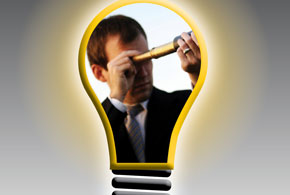“Think outside the box” is an old, tired cliché. It emerged in the 1960s, and was quickly and thoroughly expropriated by so-called management gurus.
Like all clichés, the think-outside-the-box slogan is rooted in a good idea. Today, more than ever, entrepreneurs, leaders, and technology and business managers need to understand and master the art of how to think outside the box.
The “box” originated as the classic “Nine Eggs” puzzle, also known as the “Nine Dots” puzzle. You can do the puzzle yourself. Draw nine circles (eggs) or dots with three stacked rows of three, which forms a square or box. Now draw as few straight lines as you can to connect all dots.
When people stay inside the box, it can be done with six lines. But by extending lines outside the box, it can be done in four.
In business circles, the box is metaphorical, and represents conditioned, expected, conventional thinking. And, it turns out, thinking outside that box is a great idea. But it’s hard.
Few People Want to Think Outside the Box
Marc Andreessen is one of Silicon Valley’s best out-of-the-box thinkers. He co-authored Mosaic, the first popular web browser, co-founded Netscape, and is now a co-founder and general partner of the venture capital firm Andreessen Horowitz.
The company has a podcast called a16z. In a recent episode, Andreessen pointed out that other countries can’t replicate Silicon Valley because they can’t think outside of their national boxes about how business and politics work. He said (at around 30:40 in the podcast):
“We frequently have delegations coming to Silicon Valley from … all over the world … and they’re like: ‘OK, what can we do to have our own Silicon Valley?’ And then you sit down and [tell them] ‘You want rule of law, you want ease of migration, you want ease of trade, you want deep investments in scientific research, you want no non-competes, you want a slew of labor laws to allow ease of companies to both hire and fire, you want the ability of entrepreneurs to start companies very quickly, you want bankruptcy laws that make it very easy to move on and start another company’ and, at some point, the visitors get this stricken look on their face … and they’re like: ‘What if we want Silicon Valley, but we can’t do any of those things?'”
And this is how out-of-the-box thinking often goes in business. Companies and managers and team leaders want the benefits of out-of-the-box thinking, but they can’t accept the thinking itself.
Out-of-the-box thinking is a skill that can be cultivated and developed over time. But with that new way of thinking, you need another set of skills to bring others along. Otherwise, out-of-the-box thinking can simply lead to wasted time, personal stigmatization and the loss of influence.
More to the point, far too many people in business believe out-of-the-box thinking is identical to “wild ideas” or “creative thinking.” In reality, it requires a full, deep understanding of the box itself.
There are three categories of professionals who are masters of out-of-the-box thinking: opinion columnists, magicians and comedians.
How Opinion Columnists Think Outside the Box
Opinion columnists (like me) exist in part to expose misguided thinking by the public: to bust myths, clear up misconceptions and clarify what’s wrong with widely held but erroneous beliefs.
For example, I wrote a piece for Medium defending “coffee shop campers” against critics who say people shouldn’t sit there all day taking up a table. The conflict is about a new rule of social etiquette that emerged when coffee shops started offering WiFi for patrons. So what’s the rule? Is it rude to spend hours in a coffee shop using one’s laptop, or is it OK?
Most people, I suspect, believe coffee shop camping to be rude behavior. But the box—the cultural context underlying this belief—is the expected role of consumers in a consumer marketplace.
Inside that box, a coffee shop is a business that sells coffee. As a consumer, your role is to buy coffee, enjoy the chairs and tables for as long as it takes to consume that coffee, and then go away to make space for the next consumer. We’ve been conditioned to behave like this, and to bus our own tables, too.









